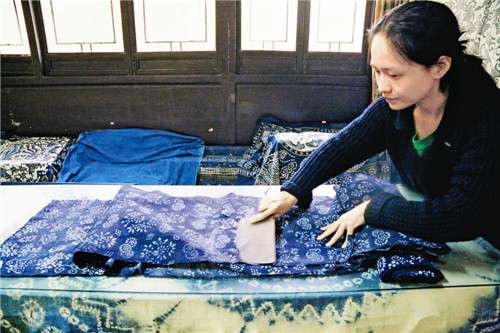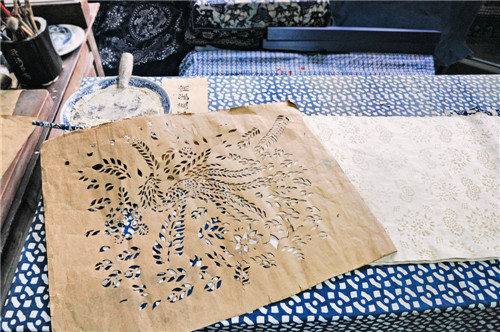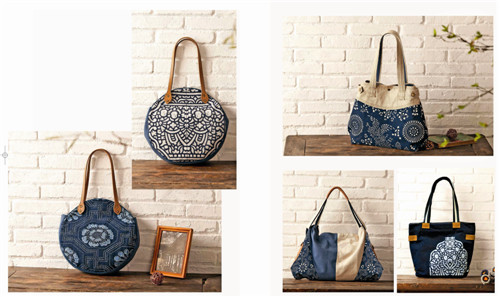
Wu Lingshu, who was born in 1988 in Qidong, is the Nantong municipal-level inheritor of the craft of creating calico. She is deputy curator of the Nantong Calico Museum and director of the Nantong Calico Research Center (affiliated with Nantong University). During the past several decades, she has collected nearly 1,000 calico items created by folk artists. In recent years, several of her works have earned her the Mountain Flower Award, the top prize for China's folk arts.
Nantong, a city in East China's Jiangsu Province, is renowned for its production of blue calico with white patterns (also referred to as white calico with blue patterns). The patterns on the cloth embody the city's distinct cultural features, and its rich historical and cultural messages. In 2006, China added the craft of creating Nantong's calico to the list of the country's items of intangible cultural heritage.
During the past several decades, Wu Yuanxin, a craftsman in Qidong, a county-level city under the jurisdiction of Nantong, and his family members have made great contributions to the promotion of the traditional craft. In particular, Wu Lingshu, Wu Yuanxin's daughter, has exerted every effort to study the traditional craft, and to improve her craft-making skills.
Records indicate the craft of creating Nantong's calico dates back more than 2,000 years. The craft originated during the Han Dynasty (206 BC-220 AD), and it reached the height of its popularity during the Tang (618-907) and Song (960-1279) dynasties.
In the past, almost all of the families in cities in Jiangsu and Zhejiang (in East China) provinces created calico. The residents used the cloth to make quilts' covers, pillowcases, curtains, scarves, clothes and other items.
As the machine-made cloth and foreign dye have sold well at home since the Republic of China (1912-1949), the handmade calico has been almost eliminated by the market. Nantong has been one of China's few production areas of calico.
To make the calico, craftsmen must complete complicated procedures — including spinning yarn, weaving cloth, cutting blocks (for dyeing the cloth), printing patterns on the calico and using the sap of Indigowoad Root to dye the cloth — by hand.
The patterns, which convey blessings for happiness and good luck, embody people's desire to enjoy the good life. In addition to characters and plants, auspicious patterns, such as a dragon and a phoenix, are printed on the cloth to represent prosperity and good luck. Other patterns include mandarin ducks, playing on water, to symbolize a devoted couple living in peace and harmony, and cranes under pine trees, to symbolize longevity.
Wu Lingshu was born into a family of craftspeople in Qidong. "My father is curator of the Nantong Calico Museum. My mother was good at making embroideries. My grandma was an expert in weaving calico, and my grandpa was good at dyeing calico and printing patterns on it. For generations, our family has grown cotton, woven and dyed calico and printed patterns on it," says Wu Lingshu.
Wu Lingshu remembers when she was a little girl and Wu Yuanxin took her to Shanghai during one of his business trips. After she noticed her father was absorbed in the calico, Wu Lingshu asked him if the calico was his son. Wu Yuanxin replied smilingly, "The cloth is your grandpa's grandpa."
During her childhood and adolescence, Wu Lingshu spent much time in her father's museum. She witnessed how the small showroom developed into an exhibition center, with a dye house, and how it eventually became one of China's few museums of the calico-making craft.
Wu Lingshu began studying, with Wu Yuanxin, how to paint when she was a little girl. When she studied in a primary school, she often helped her parents share information about calico to the museum's visitors.
In 2006, Wu Lingshu was admitted to the School of Design and Arts, under Beijing Institute of Technology. During her first year at the university, she used Nantong's calico to design and create a tablecloth.
In 2008, Wu Lingshu went to Seoul, capital of the Republic of Korea, to study art design at Konkuk University. She read many books on the traditional Chinese craft of creating calico. Impressed by local people's enthusiasm for promoting the traditional craft, Wu Lingshu decided to do her bit to revive the craft of creating Nantong's calico.
In 2010, Wu Lingshu was admitted to the Chinese National Academy of Arts, China's only arts-related scientific research institute at the State level. After she completed her first-year postgraduate program on art design at the academy, she returned to Nantong to work as a part-time craftswoman with her father's museum. Since then, she has immersed herself in the blue-and-white world day in and day out.
"Compared with machine-made cloth, our calico is softer, and our handmade products are the result of craftspeople's wisdom," says Wu Lingshu. "For years, my father has led his employees in collecting calico items created by folk artists, inheriting the calico-making craft and innovating the technical skills used to make the calico."
In recent years, she has put a lot of effort into improving and innovating techniques used to create calico, to add beauty to her artworks. She has had several treatises published on the craft. In addition, she has provided, free of charge, lectures to university students in different regions of the country, to help the youngsters better understand the beauty of the art.




